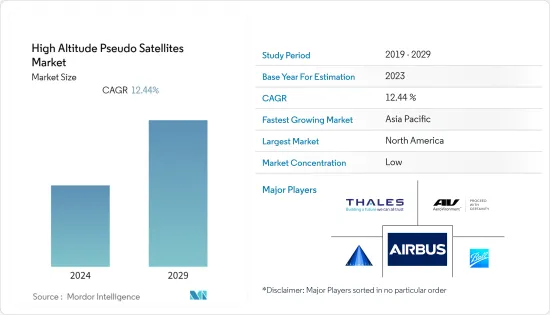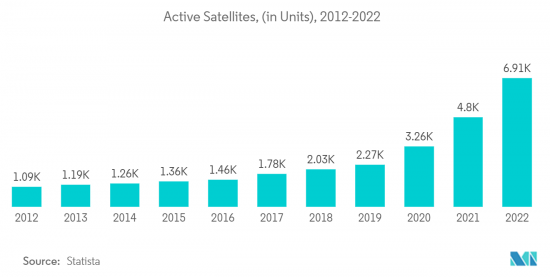
고고도 유사 위성 시장은 2024년에는 8억 5,000만 달러에 이를 것으로 평가되었고 2029년에는 15억 4,000만 달러에 이를 것으로 예측되며, 예측 기간 동안 복합 연간 성장률(CAGR) 12.44%를 기록할 전망입니다.

HAPS는 지상 통신 시스템과 위성 통신 시스템의 장점을 겸비합니다. HAPS는 기존의 정지 위성보다 훨씬 경제적인 가격 대 성능 마진으로 음성, 비디오 및 광대역 서비스를 효율적으로 제공함으로써 위성의 용량과 성능 제약을 해소합니다. 따라서 대용량 무선 서비스, 특히 지상 네트워크가 제한된 원격지에서의 마지막 마일 딜리버리에 대한 수요를 충족시키기 위해 통신 서비스 제공업체의 채용이 증가하고 있습니다.
HAPS는 제조 및 운영이 보다 경제적이지만, 이러한 플랫폼의 내구성은 그 효과를 제한합니다. 무인 항공기(UAV)와 같은 HAPS 플랫폼의 경우, 플랫폼의 내구성을 높이기 위해 전기 추진 시스템이 통합되어 있습니다. 그 결과, HAPS 플랫폼의 내구성을 높이기 위해 강력한 배터리 시스템과 고충전 밀도의 태양전지판 개발을 위해 엄청난 R&D 투자가 이루어지며, 통신 및 긴급 서비스 사업자의 최종 사용자 에 의한 채용이 보다 현실적인 것이 되었습니다.
HAPS는 지구 대기의 성층권에서 운용되며, 공기 밀도는 해수면에 비해 약 7%입니다. 따라서 공중 시스템은 몇 가지 운영상의 어려움에 직면하고 있습니다. 예를 들어, 발생하는 양력은 공기 밀도의 직접 함수이기 때문에 이러한 플랫폼은 지속적인 비행을 달성하기 위해 더 큰 날개 면적(고정 날개 UAV의 경우) 또는 부피(비행선 및 풍선의 경우)가 필요할 수도 있습니다. 설계 중량 사양을 준수하기 위해 시스템 설계자는 중량 최적화를 달성하기 위해 비교적 고도로 가벼운 재료를 도입해야 합니다. 예를 들어 Google은 Project Loon을 위해 다양한 재료를 실험하고 있습니다. 그들은 룬 성층권 풍선 프로젝트에 금속화 마일러, 이축 연신 폴리에틸렌 테레프탈레이트(BoPET), 유연한 클로로프렌 조합을 사용한다고 가정합니다. 마찬가지로 Facebook은 Aquila의 프로토 유형 제조에 T700 탄소섬유를 사용했습니다. HAPS 모델의 지속적인 개발은 예측 기간 동안 경량 재료를 향한 연구 개발을 촉진할 것으로 보입니다.
비행선 부문은 2023년 최대 시장 점유율을 차지할 것으로 예상됩니다. HAPS는 지표에서 20km 상공의 성층권에서 운용되기 때문에 통신 및 감시에 효과적인 도구입니다. HAPS는 비행선의 유연성과 위성의 내구성을 미션에 활용합니다. 이러한 서비스를 제공하기 위해 무인기구에 의지하기 위해서는 날씨와 탑재 에너지원의 제한과 같은 과제가 있습니다. 비행선은 더 많은 페이로드를 들어 올리고 동력을 공급할 수 있기 때문에 다른 플랫폼보다 선호됩니다. 비행선은 도달하기 어려운 장소를 포함하여 광범위한 범위를 빠르고 효과적으로 커버할 수 있습니다. 비행선의 다른 장점은 저렴한 비용, 유연성 및 배포 용이성입니다. 비행선은 통신 장비, 센서, 카메라와 같은 특수 페이로드를 운반하기 위해 사용자 정의됩니다. 예를 들어, 2021년 8월, Sceye(미국)는 3개월 만에 비행선 플랫폼의 세 번째 비행 시험을 성공시켰습니다. 비행선 테스트의 주요 목적은 전망 외 명령, 자세 및 자동 압력 제어, 신뢰성 높은 발사와 상승을 확인하는 것이었습니다. Sceye 비행선은 6만 5,000피트까지 비행 가능하며 태양에너지를 동력원으로 하고 있습니다.
마찬가지로 2023년 3월, 탈레스는 EuroHAPS 고도의 플랫폼 시스템 프로젝트에서 4,600만 달러의 계약을 획득했습니다. 이 프로젝트는 11개국으로 구성된 유럽 컨소시엄을 위한 성층권 플랫폼을 설계하기 위한 것입니다. 탈레스는 장시간 비행이 가능하며 대하중의 미션용 비행선인 태양광 발전 비행선 스트라토버스를 제공합니다. EuroHAPS의 주요 파트너는 CIRA(이탈리아), Elettronica(이탈리아), Leonardo(이탈리아), ONERA(프랑스), CEA(프랑스), INTA(스페인), ESG(독일), TAO(독일)입니다.

아시아태평양 개발도상국에서는 원격지에서 통신 서비스를 확보하기 위한 중요한 인프라가 없기 때문에 HAPS의 채택률이 매우 높습니다. HAPS 플랫폼은 수색 구조(SAR) 임무, 재해 구조, 환경 모니터링, 정밀 농업에 도움이 됩니다. 인도와 같은 아시아태평양의 일부 정부는 HAPS의 사전 도입 시험을 허용하고 이러한 시스템의 실현 가능성을 비판적으로 분석했습니다. HAPS는 또한 비용 효율적인 광대역 서비스를 효율적으로 제공하고 고정 또는 모바일 사용자에게 광대역 액세스를 장기적으로 제공하는 적절한 대체 인프라로 실행할 수 있습니다. 예를 들어, 성층권 풍선은 약 3-5년의 장기간 목적지 상공에 체공하여 약 500km2의 영역을 커버할 수 있습니다. 예를 들어, 2023년 3월에는 국립항공우주연구소(NAL)가 인도 최초의 고고도 플랫폼(HAP)을 출시했습니다. 고고도 플랫폼은 특히 무선 액세스 및 긴급 통신과 같은 통신 분야에서 많은 용도가 있습니다. 이 장치는 보안 당국이 국경을 엄중하게 경계하고 침입과 밀수를 방지하는 데에도 도움이 됩니다. 또한, 지방 행정은 이 장치를 사용하여 오염을 확인하고 지역 개발 활동을 파악할 수 있습니다. 과학기관은 HAP의 본격적인 버전은 3년 정도로 완성한다고 발표했습니다.
마찬가지로 2022년 1월 Sky Perfect JSA, NTT, DOCOMO, Airbus는 우주 기반 무선 연결 생태계의 일부로 HAPS 기반 연결 서비스를 연구 및 탐구하기 위해 제휴했습니다. NTT와 SKY Perfect JSAT는 우주 ICT 인프라 프로젝트에서도 제휴하여 우주 통합 컴퓨팅 네트워크를 개발했습니다. 이와 같이 시장 진출기업의 연구개발 노력은 아시아 각국의 양호한 도입 동향과 함께 예측기간 동안 아시아태평양에서의 HAPS의 도입을 촉진할 것으로 예상됩니다.
고도의 의사 위성 시장은 적당히 통합되어 경쟁이 치열하고 각 회사가 최대 시장 점유율을 얻으려고 경쟁하고 있습니다. 스펙트럼 관리 과제, HAPS의 내구성 한계, 진행 중인 프로젝트 중단은 시장 성장을 방해할 것으로 예상됩니다. 시장 진출기업은 자사 제조 능력, 세계 기지망, 제품 제공, R&D 투자, 강력한 고객 기반을 바탕으로 경쟁하고 있습니다. AeroVironment, Inc., Airbus SE, Ball Corporation, Prismatic(BAE Systems plc), THALES가 5대 시장 진출 기업입니다. 각 회사는 가격대에서 기술 제공과 통합 능력을 바탕으로 경쟁하고 있습니다. 높은 고도 플랫폼의 조달률이 상승함에 따라 예측 기간 동안 시장 성장이 촉진될 것으로 예상되므로 신제품을 출시하기에 좋은 타이밍입니다. 신규 참가업체의 위협은 완만하기 때문에 제품/서비스의 확대와 기술 혁신 증가로 시장의 경쟁환경은 더욱 격화될 것으로 보입니다. 예를 들어, 2022년 2월, 인도 국방부(MoD)는 고고도 유사 위성(HAPS) 개발을 위해 항공우주신흥기업 NewSpace와 계약을 체결했습니다. 이 이니셔티브는 MoD의 Innovations for Defence Excellence(iDEX) 프로그램의 일부입니다. 인도 육군의 지원을 받아 Hindustan Aeronautics Limited(HAL)도 프로토 유형 개발의 리드 파트너로 참여합니다.

The High-altitude Pseudo Satellites Market is valued at USD 0.85 billion in 2024 and is anticipated to reach USD 1.54 billion by 2029, registering a CAGR of 12.44% during the forecast period.
HAPS incorporates the best aspects of terrestrial and satellite-based communication systems. They eliminate the capacity and performance limitations of satellites by efficiently delivering voice, video, and broadband services at much more economical pricing vs. performance margins than conventional geostationary satellites. Hence, they are being increasingly adopted by telecommunication service providers to satiate the demand for high-capacity wireless services, especially last-mile delivery in remote areas with limited ground-based network coverage.
Though HAPS are more economical to manufacture and operate, the endurance of such platforms limits their effectiveness. In the case of HAPS platforms, such as unmanned aerial vehicles (UAVs), an electric propulsion system is integrated to enhance the endurance of the platform. It resulted in significant R&D investments towards the development of powerful battery systems and high-charge density solar panels to enhance the endurance of HAPS platforms, thereby making it more feasible for adoption by telecom and emergency service provider end-users.
HAPS operates at the stratospheric layer of the Earth's atmosphere, where the air density is around 7% compared to that at sea level. Hence, airborne systems face several operational challenges. For instance, since the lift generated is a direct function of air density, such platforms may also require a larger wing area (in the case of a fixed-wing UAV) or volume (in the case of an airship or balloon) to achieve sustained flight. To ensure compliance with the design's weight specifications, system designers must incorporate relatively advanced and lightweight materials for achieving weight optimization. For instance, Google is experimenting with a variety of materials for Project Loon. They envisioned using a combination of metalized mylar, Biaxially-oriented polyethylene terephthalate (BoPET), and highly flexible chloroprene for the Loon stratospheric balloon project. Similarly, Facebook used T700 carbon fiber for the construction of the prototype for Aquila. Ongoing development of HAPS models is also envisioned to foster the R&D towards lightweight materials during the forecast period.
The airship segment is expected to contribute the largest market share in 2023. HAPS are effective tools for communication and surveillance as they operate from the Stratosphere, which is 20 km above the Earth's surface. HAPS uses the flexibility of airships with satellite endurance in missions. There are challenges to relying on unmanned balloons to provide such services, for instance, weather and limited onboard energy sources. Airships are preferred more over other platforms due to their capability to lift and power more payload. Airships can cover large areas quickly and effectively, including hard-to-reach locations. Other benefits of airships are low cost, flexibility, and ease of deployment. Airships are customized to carry specialized payloads such as communication equipment, sensors, and cameras. For instance, in August 2021, Sceye (US) completed a third test of the airship platform flight successfully in three months. The primary objectives of the airship test were to check beyond-line-of-sight command, attitude and automated pressure control, and reliable launch and ascent. Sceye airship can fly to 65,000 ft and is powered by solar energy.
Similarly, in March 2023, Thales received a USD 46 million contract for the EuroHAPS High-Altitude Platform Systems project. The project aims to design a stratospheric platform for a European consortium of eleven countries. Thales will provide the solar-powered airship Stratobus, which is a long-endurance, large-payload mission airship. The primary partners of EuroHAPS are CIRA (Italy), Elettronica (Italy), Leonardo (Italy), ONERA (France), CEA (France), INTA (Spain), ESG (Germany), and TAO(Germany).

The adoption of HAPS is significantly high in developing countries in the Asia-Pacific region due to the absence of critical infrastructure to ensure telecommunication services in remote locations. HAPS platforms are instrumental in search and rescue (SAR) missions, disaster relief, environmental monitoring, and precision agriculture. Several governments in Asia-Pacific, such as India, permitted the pre-deployment testing of HAPS to critically analyze the feasibility of such systems in the countries. HAPS also efficiently delivers cost-effective broadband services and is viable as a suitable alternative infrastructure for the long-term provision of broadband access to fixed or mobile users. For instance, stratospheric balloons can stay afloat over their destined region for long periods of about 3-5 years and provide coverage over an area of around 500 km2. For instance, in March 2023, the National Aerospace Laboratories (NAL) launched India's first High Altitude Platform (HAP). High Altitude Platform includes a lot of applications, especially in communication like wireless access and emergency communication. The device can also help security agencies to keep a tight vigil at borders and prevent infiltrations and smuggling. The local administration can also use the device to check pollution and take stock of development activities in the area. The scientific agency informed that the full-fledged version of HAP will be ready in around three years.
Similarly, in January 2022, Sky Perfect JSAT, NTT, DOCOMO, and Airbus partnered to study and explore HAPS-based connectivity services as part of a space-based wireless connectivity ecosystem. NTT and SKY Perfect JSAT also partnered in the outer space ICT infrastructure project and developed a space-integrated computing network. Thus, the R&D efforts of the market players, coupled with favorable adoption trends in different Asian countries, are anticipated to drive the adoption of HAPS in the Asia-Pacific region in the forecast period.
The high-altitude pseudo-satellites market is moderately consolidated and highly competitive, with players competing to gain the largest market share. Spectrum management challenges, endurance limitations of HAPS, and the cancellation of ongoing projects are envisioned to impede the growth of the market. Market players compete based on their in-house manufacturing capabilities, global footprint network, product offerings, R&D investments, and strong client base. AeroVironment, Inc., Airbus SE, Ball Corporation, Prismatic (BAE Systems plc), and THALES are the five major market players. They compete based on technological offerings and integration capabilities at a given price point. An increase in the high-altitude platform procurement rate is expected to fuel the market growth during the forecast period, thereby making it an ideal time to launch new products. Since the threat of new entrants is moderate, the competitive environment in the market is likely to intensify further due to an increase in product/service extensions and technological innovations. For instance, in February 2022, the Ministry of Defence (MoD) (India) inked a deal with aerospace startup NewSpace for the development of a High-Altitude Pseudo Satellite (HAPS). The initiative is part of the MoD's Innovations for Defence Excellence (iDEX) program. Backed by the Indian Army, the initiative will also see Hindustan Aeronautics Limited (HAL) come on board as the lead prototype development partner.